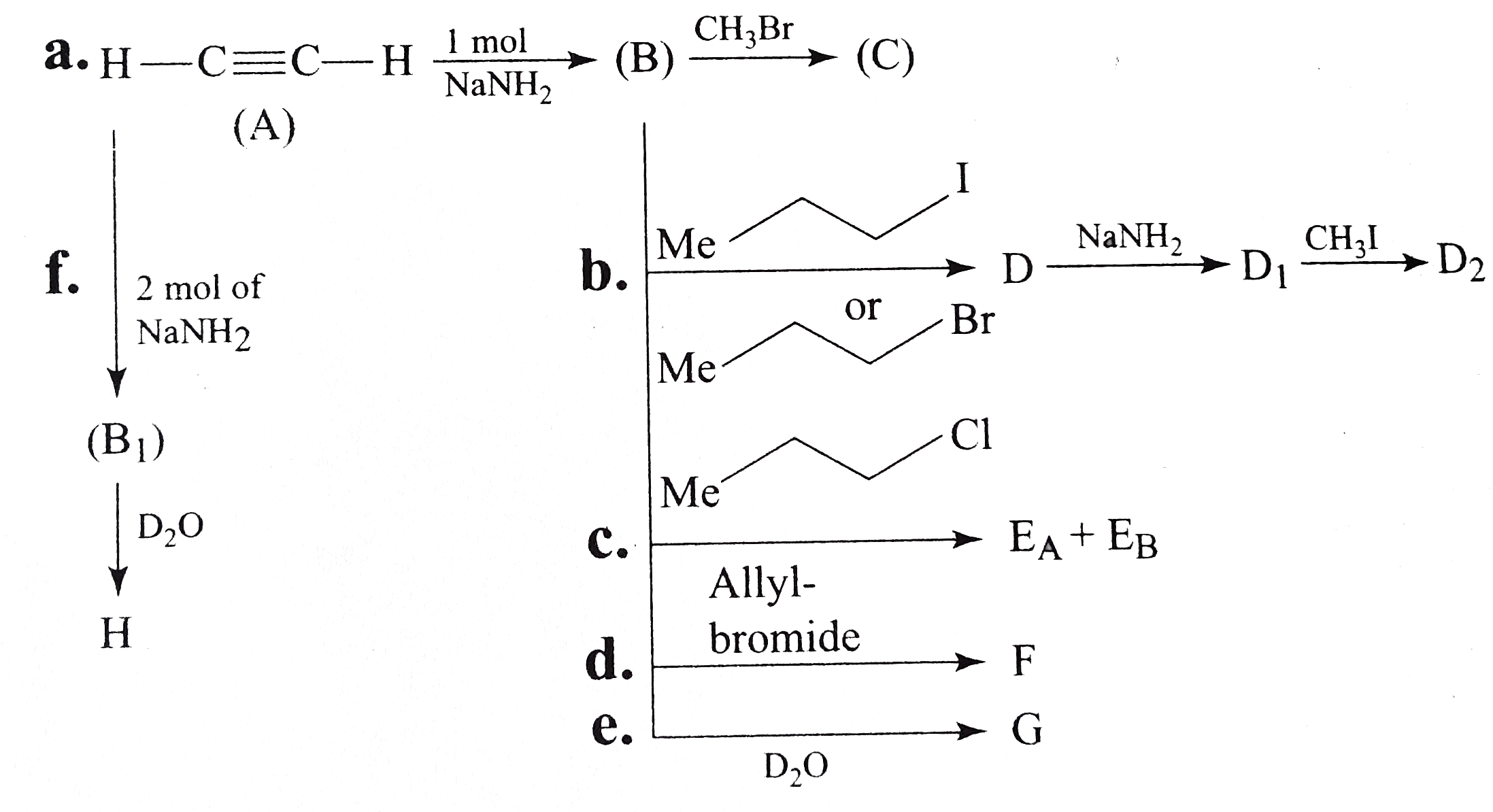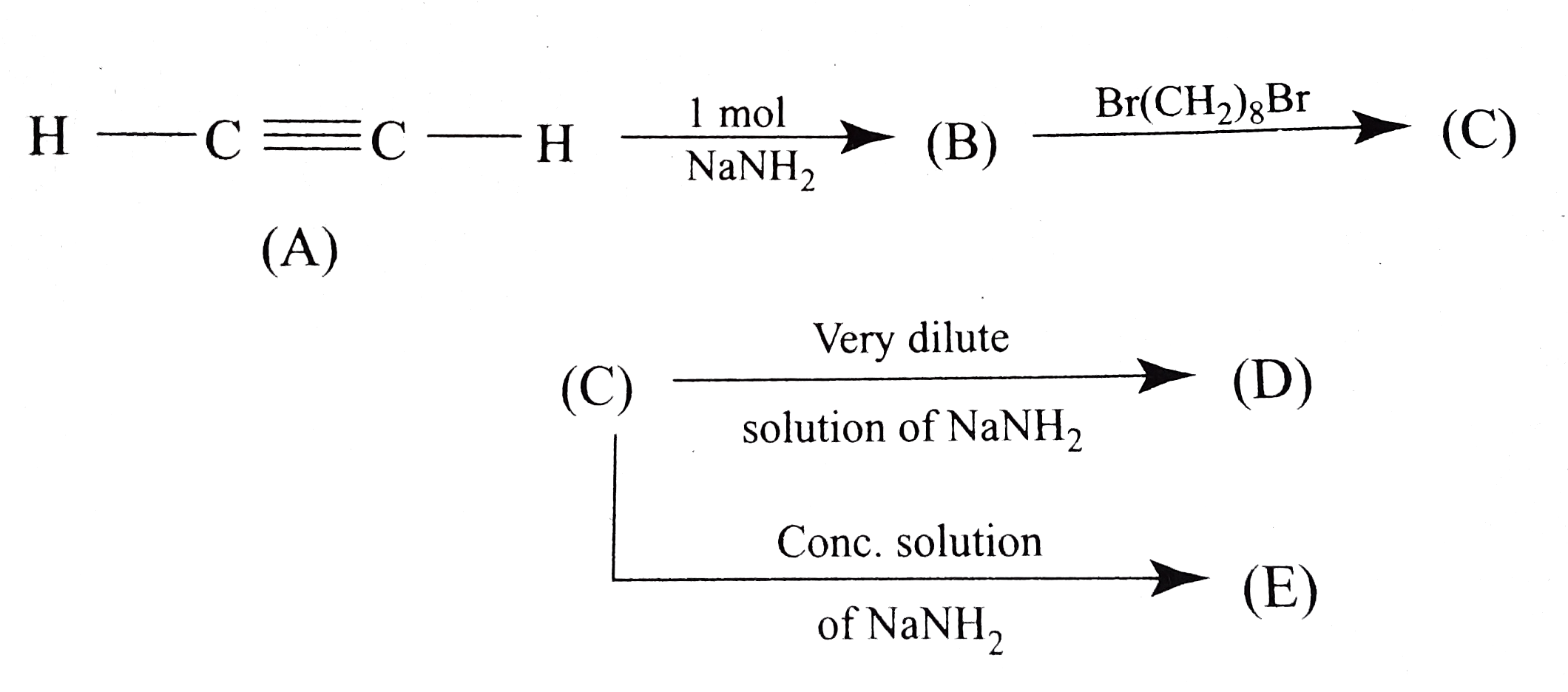In the following sequence of reactions, the products (A) to (G) are formed:
i. 2CH4(g)Δ−−−→1773K(A)(g)+B(g)
ii. 4molof(A)Δ−−−−−−−−−−→Ni(CN)4+THF(C)O3/oxid.−−−−−→(D)only
iii. (A)(1)1molofNaNH2−−−−−−−−−−−→(2)C2H5I(E)3molofE−−−−−−→RedhottubeF⏐↓O3/Red.(G)only
Compound F is
Mesitylene
1,2,3-Triethylbenzene
1,2,3-Trimethylbenzene
1,3,5-Triethylbenzene
The correct Answer is:D
To solve the problem step by step, we need to analyze the reactions provided and identify the compounds formed at each stage.
Step 1: Identify Compound A
The first reaction is:
2CH4(g)Δ→(A)(g)+B(g)
When two molecules of methane (CH₄) are heated at high temperatures (1773 K), they undergo a process called pyrolysis, which can lead to the formation of ethane (C₂H₆) and hydrogen gas (H₂). In this case, we can identify:
- Compound A = C₂H₆ (Ethane)
- Compound B = H₂ (Hydrogen)
Step 2: Identify Compound E
The third reaction is:
(A)(1)1 mol of NaNH2→(2)C2H5IE
In this step, ethane (C₂H₆) reacts with sodium amide (NaNH₂) and ethyl iodide (C₂H₅I). The sodium amide acts as a strong base and deprotonates ethane to form the ethyl anion (C₂H₅⁻). This anion then reacts with ethyl iodide to form butane (C₄H₁₀).
- Compound E = C₄H₁₀ (Butane)
Step 3: Identify Compound F
The next part of the reaction is:
(Red hot tube)3 mol of E→→(G) onlyF
In the red-hot tube, butane (C₄H₁₀) undergoes pyrolysis or cracking, which can lead to the formation of various products, including alkynes. When butane is subjected to strong heating, it can yield ethyne (acetylene, C₂H₂) as one of the products.
- Compound F = C₂H₂ (Ethyne)
Final Answer
Thus, the compound F is C₂H₂ (Ethyne).
---
The first reaction is:
2CH4(g)Δ→(A)(g)+B(g)
- Compound A = C₂H₆ (Ethane)
- Compound B = H₂ (Hydrogen)
The third reaction is:
(A)(1)1 mol of NaNH2→(2)C2H5IE
- Compound E = C₄H₁₀ (Butane)
The next part of the reaction is:
(Red hot tube)3 mol of E→→(G) onlyF
- Compound F = C₂H₂ (Ethyne)
Thus, the compound F is C₂H₂ (Ethyne).
Topper's Solved these Questions
- BOOK - CENGAGE CHEMISTRY ENGLISHCHAPTER - ALKYNESEXERCISE - Exercises (Multiple Correct Answers Type)25videos
ALKYNES
- BOOK - CENGAGE CHEMISTRY ENGLISHCHAPTER - ALKYNESEXERCISE - Exercises (Single Correct Answers Type)30videos
ALKYNES
- BOOK - CENGAGE CHEMISTRY ENGLISHCHAPTER - ALKYNESEXERCISE - Exercises (Subjective Type)31videos
ALKYNES
- BOOK - CENGAGE CHEMISTRY ENGLISHCHAPTER - ALKENES AND ALKADIENESEXERCISE - Single correct Answer14videos
ALKENES AND ALKADIENES
- BOOK - CENGAGE CHEMISTRY ENGLISHCHAPTER - APPENDIX - INORGANIC VOLUME 1EXERCISE - chapter-7 Single correct answer1videos
APPENDIX - INORGANIC VOLUME 1
Similar Questions
In the following sequence of reactions, the products (A) to (G) are formed:
i. 2CH4(g)Δ−−−→1773K(A)(g)+B(g)
ii. 4molof(A)Δ−−−−−−−−−−→Ni(CN)4+THF(C)O3/oxid.−−−−−→(D)only
iii. (A)(1)1molofNaNH2−−−−−−−−−−−→(2)C2H5I(E)3molofE−−−−−−→RedhottubeF⏐↓O3/Red.(G)only
Compounds G isView SolutionIn the following sequence of reactions, the products (A) to (G) are formed:
i. 2CH4(g)Δ−−−→1773K(A)(g)+B(g)
ii. 4molof(A)Δ−−−−−−−−−−→Ni(CN)4+THF(C)O3/oxid.−−−−−→(D)only
iii. (A)(1)1molofNaNH2−−−−−−−−−−−→(2)C2H5I(E)3molofE−−−−−−→RedhottubeF⏐↓O3/Red.(G)only
Compounds (A) and (B), respectively, are:View Solution
Knowledge Check
- Question 1 - Select One
H3C−CH3∣C∣CH3−H+CCl4R2O2−−→hvProduct :
AH3C−CH3∣C∣CH3−ClBCHCl3CBoth (a) and (b)DNone of these - Question 2 - Select One
 Br2−−→CCl4(i)alc. KOH−−−−−−−→(ii)NaNH2(A)major, Product (A) is :AH2C=CH−CH=CH2BCH3−C≡C−CH3CCH3−CH2−C≡CHDCH3−CH=C=CH2
Br2−−→CCl4(i)alc. KOH−−−−−−−→(ii)NaNH2(A)major, Product (A) is :AH2C=CH−CH=CH2BCH3−C≡C−CH3CCH3−CH2−C≡CHDCH3−CH=C=CH2
In the following sequence of reaction, the product C is
CH3−BrKCN−−→AH2O+−−−→BLiAlH4−−−→EtherCView Solution (B)2mol−−−−−−→Cl2+hv (C)2mol−−−−−−−−→Alc.KOH
(B)2mol−−−−−−→Cl2+hv (C)2mol−−−−−−−−→Alc.KOH
(D) CH2=CH2−−−−−−−→Δ (E)
The final product (E) is :View SolutionConsider the following sequence of reactions
C2H5C≡CHCH3MgBr−−−−−→A(1)HCHO−−−−−−→(2)H2O+B
The product (B) isView SolutionIn the following reaction sequence Y is,
PhOCOCH3AlCl3−−→Δ(X)I2−−−→NaOH(Y)View Solution(CH3)2CONaCN−−−→HCI(A)H+3O−−→Δ(B)
In the above sequence of reactions, (A) and (B) are :View SolutionComplete the following reactions: a. H−C(A)≡C−H1mol−−−−→NaNH2(B)CH3Br−−−→(C)

g. H−C≡C(A)−H1mol−−−−→NaNH2(B)Br(CH2)8Br−−−−−−−−→(C)
 View Solution
View Solution

